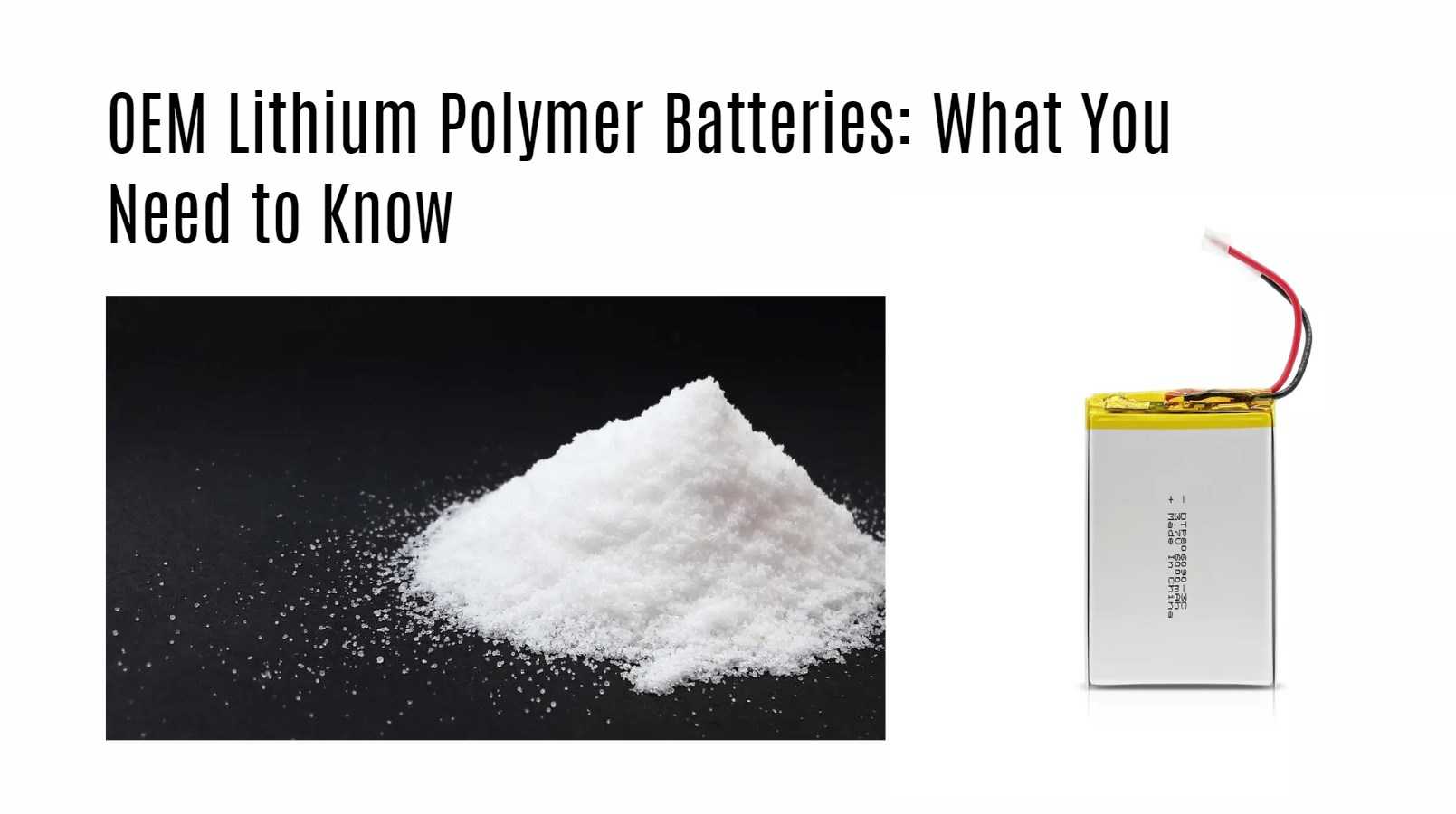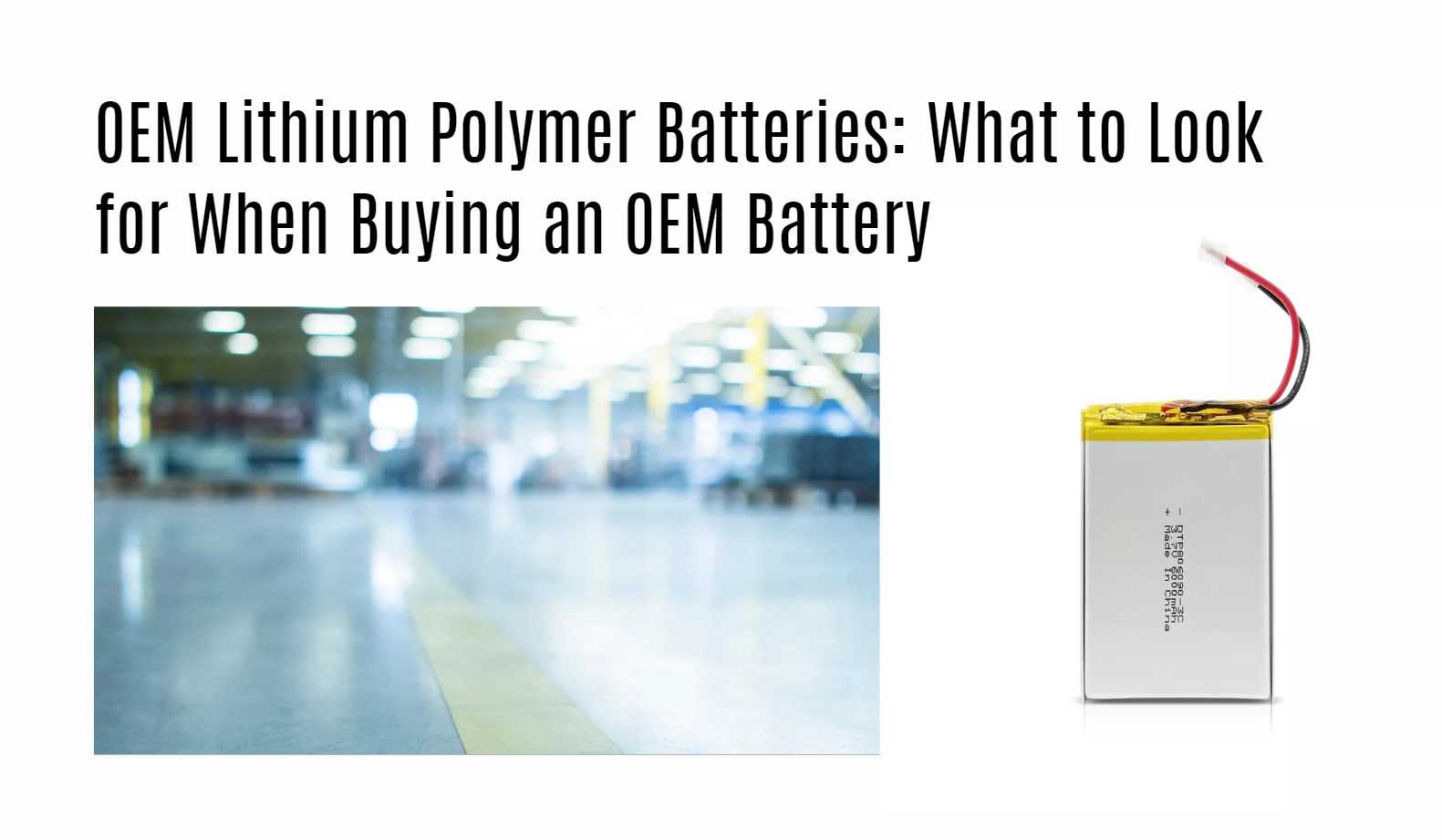Are you in the market for a new battery? Have you considered OEM lithium polymer batteries? These high-performance batteries are becoming increasingly popular due to their long lifespan and fast charging capabilities. But before you make your purchase, it’s important to understand what exactly OEM lithium polymer batteries are, as well as their pros and cons. In this blog post, we’ll dive into everything you need to know about these powerful batteries, including how to care for them and what to look for when buying one. So let’s get started!
What are OEM Lithium Polymer Batteries?
OEM lithium polymer batteries, also known as Original Equipment Manufacturer batteries, are rechargeable energy storage devices designed specifically for use in a particular electronic device. These batteries are typically found in smartphones, laptops and tablets but can also be used in other gadgets such as drones and smartwatches.
Unlike traditional Lithium-ion batteries that use liquid electrolytes, OEM lithium polymer batteries utilize solid or gel-like electrolytes which make them more flexible and safer to use. They come with various features like fast-charging capabilities, high energy density, lightweight design and improved safety measures.
Wholesale lithium golf cart batteries with 10-year life? Check here.
One of the key benefits of OEM lithium polymer batteries is their longer lifespan compared to other battery types. This means you won’t have to replace your battery as often – saving you money in the long run.
It’s important to note that not all OEM lithium polymer batteries are created equal. There are different types available on the market today ranging from low-quality knock-offs to high-end premium brands that offer superior performance characteristics.
Want OEM lithium forklift batteries at wholesale prices? Check here.
OEM lithium polymer batteries provide a reliable source of power for your electronic devices while offering exceptional performance and durability over time.
The Different Types of OEM Batteries
When it comes to OEM lithium polymer batteries, there are several different types available on the market today. Each type has unique features and specifications that cater to specific uses and applications.
One of the most common types is the cylindrical battery, which is often used in electronic devices such as laptops or tablets. These batteries are easy to manufacture and come in a range of sizes and capacities.
Another popular type is the prismatic battery, which typically offers higher energy density than their cylindrical counterparts. This makes them ideal for use in mobile phones or other small devices where space is at a premium.
In recent years, pouch cells have become increasingly popular due to their flexibility and versatility. These thin batteries can be designed into almost any shape or size, making them ideal for wearable electronics or other products with unusual shapes.
Coin cell batteries are commonly used in watches and small medical devices due to their compact size and long lifespan compared with other models.
No matter what your needs may be when it comes to OEM lithium polymer batteries, there’s sure to be a model out there that can meet your requirements perfectly!
Pros and Cons of Using an OEM Battery
When it comes to choosing a battery for your electronic device, OEM lithium polymer batteries are a popular choice. However, like any product, there are pros and cons to using an OEM battery.
Pros:
One advantage of an OEM battery is that it is specifically designed for your device. This means it will fit perfectly and work seamlessly with your device ensuring optimal performance.
OEM batteries often come with a warranty which provides peace of mind if something goes wrong.
Since they are made by the same manufacturer as your device, the quality control standards tend to be higher than third-party alternatives.
Cons:
The biggest drawback of an OEM battery is the cost. They can be more expensive than third-party options.
Another disadvantage is limited availability. Since they are only sold by the original equipment manufacturer, you may have difficulty finding one in stores or online.
Some people feel that OEM batteries lack customization options since they’re designed specifically for particular devices.
While there are both advantages and disadvantages to using an OEM lithium polymer battery, ultimately the decision depends on personal preference and need.
What to Look for When Buying an OEM Battery
When it comes to buying an OEM lithium polymer battery, there are a few things that you need to keep in mind. First and foremost, you should consider the compatibility of the battery with your device. Make sure that you get a battery that is designed specifically for your device to avoid any issues.
Another important factor to consider is the capacity of the battery. This will determine how long your device can run on a single charge. If you’re someone who uses their devices heavily throughout the day, then it’s recommended that you go for a higher-capacity battery.
It’s also important to look at the quality of materials used in making the OEM battery. A high-quality battery will not only last longer but will also be safer to use.
One thing many people overlook when buying batteries is customer support and warranty policies offered by manufacturers. It’s always important to check if they offer warranties or return policies just in case something goes wrong with your purchase.
Make sure you’re getting your OEM lithium polymer batteries from reputable sources such as authorized dealers or online shops known for providing genuine products. Never compromise on quality just because it seems cheaper elsewhere!
How to Care for Your OEM Battery
Taking care of your OEM Lithium Polymer battery is crucial for its longevity and performance. These batteries are designed to last long, but they require proper maintenance to keep them running smoothly.
Firstly, avoid exposing the battery to extreme temperatures as it can damage the cells and reduce their lifespan. Keep your device away from direct sunlight or heat sources like radiators or stoves.
Secondly, don’t let your battery drain completely before charging it. It’s best to charge it when the level drops between 20-30%. Overcharging can also damage the cells, so make sure you unplug your device once it reaches 100%.
Thirdly, use only original chargers and cables that come with your device. Avoid using third-party chargers as they may not be compatible with your battery and cause overheating or short-circuiting.
Fourthly, clean the contacts of both the charger and device regularly with a soft cloth to ensure good connectivity. This will help prevent issues like slow charging or failure to charge altogether.
If you’re storing your device for an extended period of time without use, make sure you leave its battery charged at around 50%. Storing a fully discharged or fully charged lithium polymer battery for too long can result in permanent capacity loss.
By following these simple tips on taking care of your OEM Lithium Polymer Battery, you’ll maximize its lifespan while enjoying optimal performance throughout its life cycle.
Lithium Polymer Batteries vs LiFePO4 Batteries
Lithium polymer batteries and LiFePO4 batteries are two popular options in the world of rechargeable batteries. Both offer distinct advantages and cater to different applications.
Lithium polymer batteries, also known as LiPo batteries, are lightweight and flexible, making them ideal for use in small electronic devices such as smartphones, tablets, and drones. They have a high energy density, which means they can store a large amount of power in a compact size. LiPo batteries also offer fast charging capabilities and a longer lifespan compared to other battery types. However, they can be more expensive and require careful handling and maintenance to prevent damage.
On the other hand, LiFePO4 batteries, also known as lithium iron phosphate batteries, are known for their excellent safety features and long cycle life. They are commonly used in applications that require a stable and reliable power source, such as electric vehicles, solar energy storage systems, and power tools. LiFePO4 batteries have a higher thermal stability and are less prone to thermal runaway or explosion. They also have a longer lifespan and can withstand more charge-discharge cycles compared to LiPo batteries. However, LiFePO4 batteries are generally heavier and bulkier than LiPo batteries.
In conclusion, when choosing between lithium polymer batteries and LiFePO4 batteries, it is important to consider the specific requirements of your application. If you need a lightweight and fast-charging battery for small devices, LiPo batteries are a great choice. On the other hand, if safety, reliability, and long cycle life are important factors, LiFePO4 batteries are the way to go.
Conclusion
OEM lithium polymer batteries offer a reliable and efficient power source for various electronic devices. They come in different types, each with its own advantages and disadvantages. When buying an OEM battery, it’s important to consider factors such as capacity, voltage, compatibility with your device, and safety features.
To ensure the longevity of your OEM battery and maximize its performance, it’s crucial to take proper care of it by avoiding extreme temperatures and overcharging or discharging. With proper maintenance practices in place, you can expect your battery to last longer than non-OEM alternatives.
Choosing an OEM lithium polymer battery is a smart investment that will save you money in the long run while providing peace of mind knowing that you’re using a high-quality product designed specifically for your device.







